Ever struggled with gluing plywood effectively? Discover foolproof steps to create strong, durable bonds for your woodworking projects. Ready to transform your DIY game? Let’s dive in!
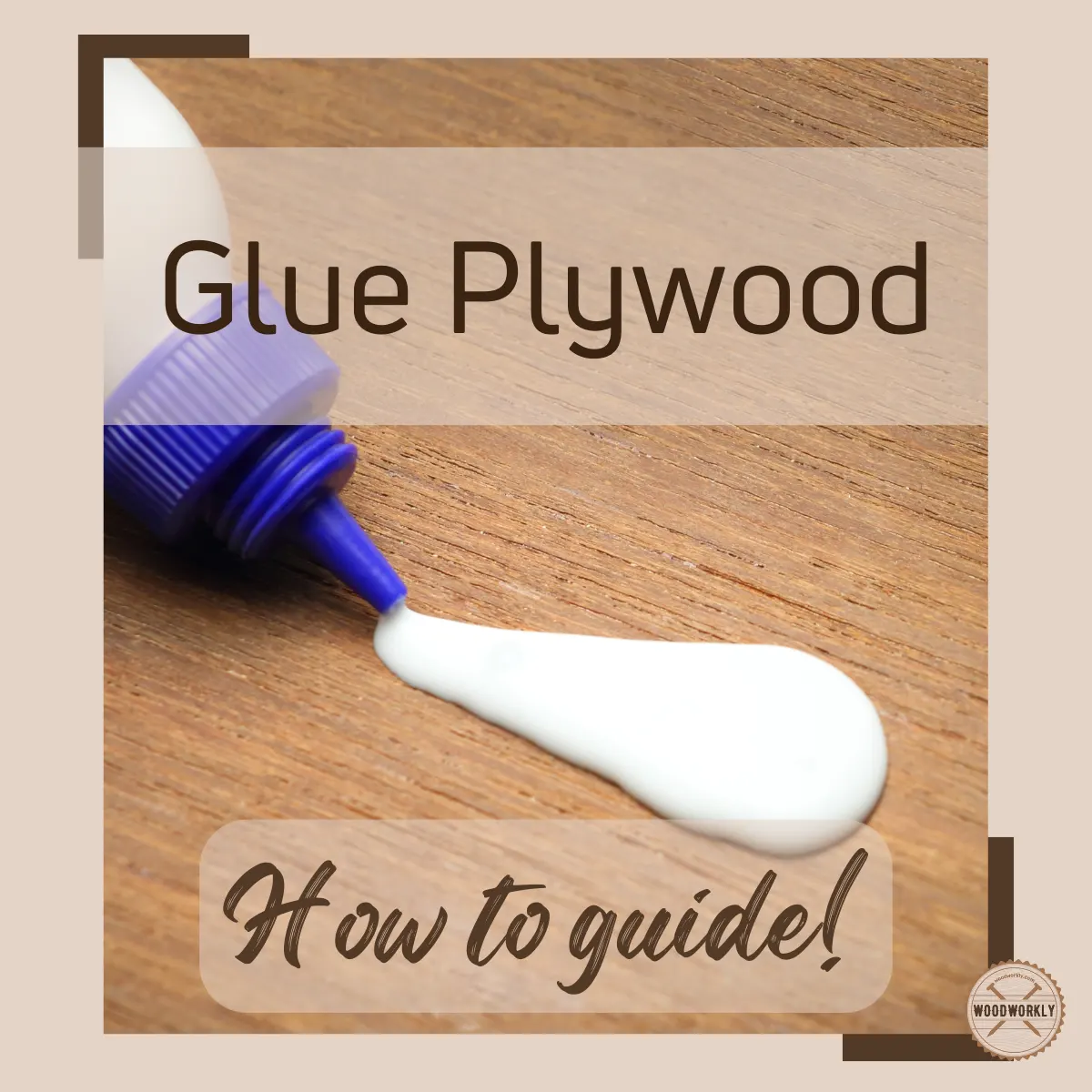
Joining plywood is a basic woodworking skill, and mastering the art of gluing plywood opens up a world of possibilities for creating strong and versatile structures.
During my early woodworking days, I was worried about gluing plywood because I was afraid of breaking and damaging it.
In order to fix this I went to the professionals in my are and was able to learn the right technique to glue plywood together without leaving a single damage on them.
Now with years of experience, let me tell you the best method anyone can use to glue plywood properly.
Here is How to glue plywood together?
To glue plywood together effectively, ensure a clean, dry surface, choose high-quality wood glue and spread it evenly on one sheet of plywood. Align the pieces, clamp them securely, drive in screws to reinforce, and follow the glue manufacturer’s instructions for curing.
But that’s just a quick snapshot!

In this article, I’ll explore the step-by-step process of effectively gluing plywood, covering essential tips, considerations and the best wood glue options for various applications.
Whether you’re an experienced woodworker or just starting out, understanding the nuances of gluing plywood together is key to achieving professional results on your projects.
We dive into the details and discover techniques that will enhance your woodworking skills.
Let’s journey begin!
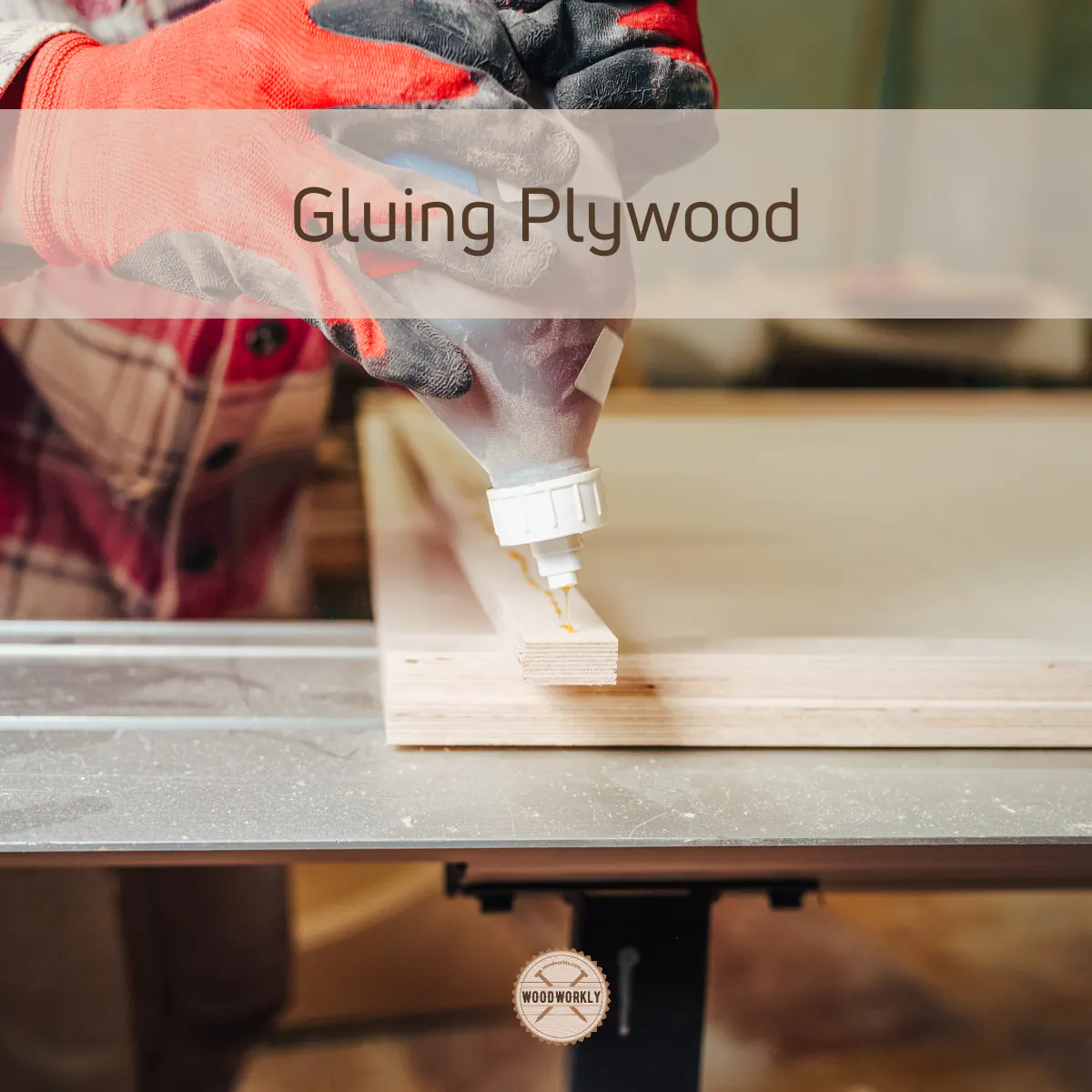
Can You Glue Plywood Together?
Yes, you can glue the plywood together using high-quality wood glue that has been formulated.
First of all, it is important to ensure that the surface to be glued is clean, dry and free of contaminants that could interfere with the adhesive bond.
When gluing plywood, you can apply an even layer of wood glue to one surface and then press the pieces firmly together.
I recommend that you always follow the manufacturer’s instructions for drying time and use clamps to hold the pieces in place while the glue dries.
Also, remember that the success of the bond depends on the type of plywood you use and the intended application.
In addition to glue, you may want to consider additional reinforcement methods such as screws or nails for critical structural applications.
I am sure that by always following the guidelines provided by the adhesive manufacturer for the best results, you will be able to ensure a strong and durable bond.

Factors You Need To Consider When Gluing Plywood
When it comes to gluing plywood, several critical factors play a role in determining the strength and durability of the bond.
I have brought you the following factors to ensure a successful and long-lasting result when gluing plywood.
- Type of Wood Glue
- Clamping Technique
- Surface Preparation
- Type of Plywood
- Reinforcement Methods
- Follow the Manufacturer’s Instructions
Now let’s talk about these factors separately.
Type of Wood Glue
Choosing the right type of wood glue is especially important among the factors you need to consider when gluing plywood.
I advise you to always choose high-quality wood glue suitable for bonding wood surfaces.
Some common choices include aliphatic resin glue (yellow glue) or polyvinyl acetate (PVA) glue.
Don’t forget to make sure the adhesive is suitable for your specific project and the conditions it will be subjected to.
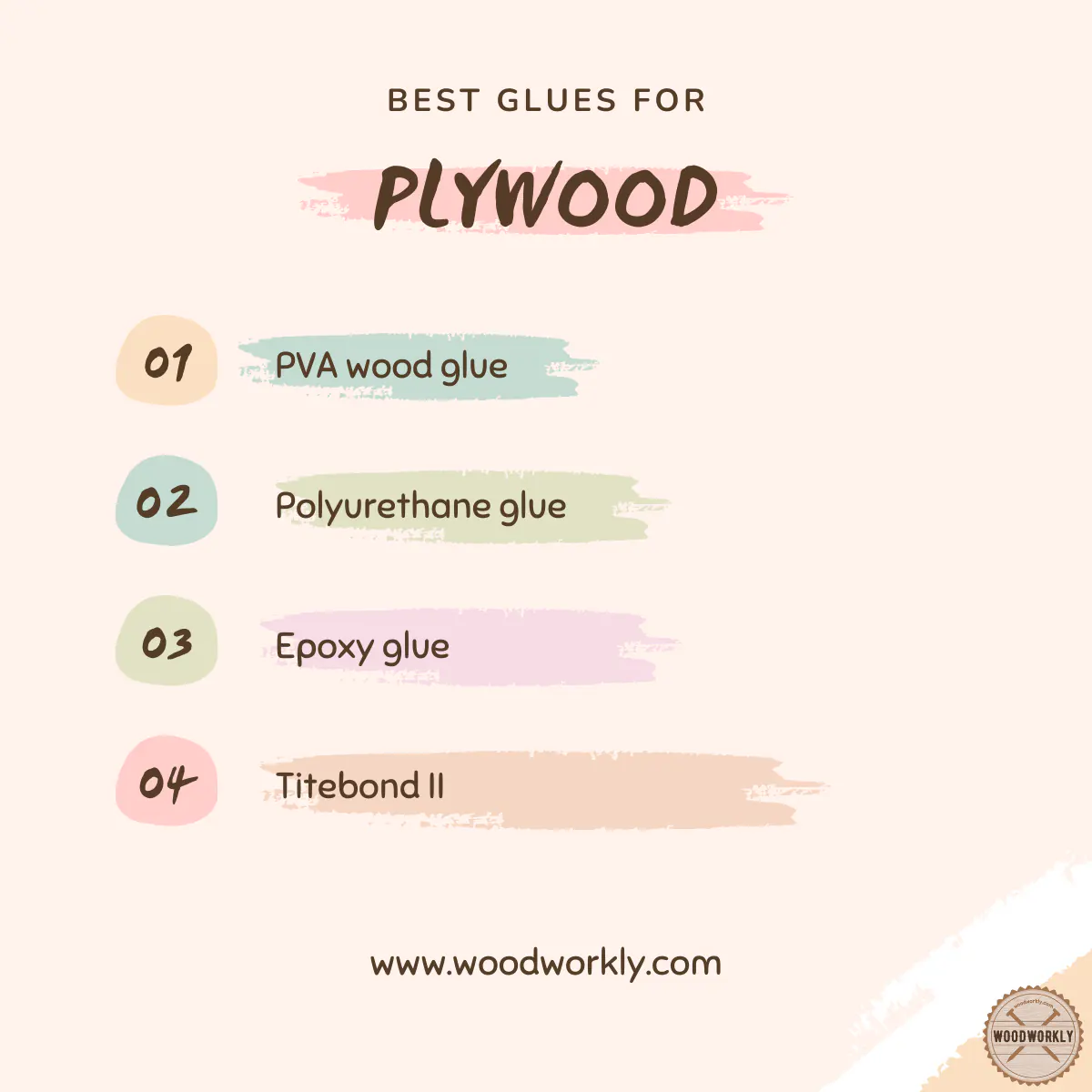
Clamping Technique
You probably already know that the use of clamps is highly recommended during the gluing process.
By using these clamps on your project, you can maintain even pressure on the glued surface, promoting a tight bond.
For successful results I would advise you to always ensure that clamping pressure is evenly distributed over the entire surface and follow the recommended drying time provided by the adhesive manufacturer.
Surface Preparation
Another important point that cannot be forgotten is the proper preparation of the surface to be glued.
Here you need to ensure that the plywood surface is clean, dry and free of dust, dirt or contaminants.
I will remind you that it is essential to lightly sand the surface to improve adhesion and to ensure that the wood is free of any previous finishes such as paint or varnish.
Type of Plywood
Different types of plywood may require specific gluing techniques.
For example, hardwood plywood and softwood plywood may have different characteristics, and the selected adhesive must be compatible with the properties of the wood.
Additionally, remember that the plywood’s intended application, whether structural or decorative, should influence the glue and bonding method you choose.
Reinforcement Methods
Depending on the application, you may want to consider additional reinforcement methods.
While a well-executed adhesive bond is strong, some projects, especially those with high tension or load-bearing requirements, may benefit from additional fasteners such as screws or nails.
This can provide additional support and help you improve the overall strength of the joint.
Follow the Manufacturer’s Instructions
Another important but overlooked factor to consider when gluing plywood is following the guidelines and recommendations provided by the wood glue manufacturer.
This includes information on application, drying time and any specific conditions required for optimal bonding, including guidelines and recommendations provided by the manufacturer.
Following these instructions will ensure you get the best results with your chosen adhesive.
I’m confident that by keeping these points in mind, you can contribute to a successful plywood gluing process that will create a strong and reliable bond for your woodworking projects.

Best Wood Glue to Join Plywood Together
Choosing the right wood glue is very important in order to achieve a strong and durable bond when joining plywood.
You can buy different types of wood glue in the market but each one has its unique characteristics and applications.
Here is a detailed description of some common wood glues I recommend and their suitability for plywood.
Aliphatic Resin Glue (Yellow Glue)
Aliphatic resin glue, commonly found on the market as yellow glue, is a popular choice for joining plywood.
It is water-based and dries to a clear, yellow color. Yellow glue is known for its excellent bond strength, fast drying time and versatility.
Yellow glue is suitable for gluing plywood sheets together, providing you with a strong and reliable joint.
Keep in mind that it is especially effective in applications where fast bonding is essential, such as woodworking projects that require quick assembly.
Polyvinyl Acetate (PVA) Glue
PVA glue is another water-based glue commonly used in woodworking. It comes in a variety of formulations, including white glue and carpenter’s glue.
PVA glue is known for its ease of use, affordability and versatility.
PVA glue is ideal for joining plywood in projects where a particularly strong bond is essential.
It is effective in a variety of woodworking applications, including laminating plywood layers. PVA glue dries to a transparent finish, making it ideal for projects where the appearance of the glue line is important.
Polyurethane Glue
Polyurethane adhesive is a versatile adhesive that expands as it cures. It is known for its strong bond, resistance to water and ability to bond various materials.
Polyurethane adhesive usually foams as it cures, filling gaps and creating a strong bond.
Polyurethane adhesives are suitable for joining plywood, especially in applications where there are gaps or irregularities in the joint.
It is effective in situations where a waterproof bond is required, making it a good choice for outdoor or marine projects involving plywood.
Epoxy Resin
Epoxy resin is a two-part adhesive consisting of a resin and a hardener. When mixed, epoxies create a strong, durable bond with excellent gap-filling properties. Epoxy is known for its versatility and high strength.
Epoxy resin is especially suitable for joining plywood in applications that require extreme strength and durability.
It is often used in structural projects or when bonding plywood to other materials. Epoxy provides a heat, chemical and moisture resistant bond.
Cyanoacrylate (CA) Glue
Cyanoacrylate glue, commonly known as super glue, is fast curing glue.
It sets quickly and forms a strong, clear bond. CA glue is available in different viscosities, allowing for a variety of applications.
Although not common for large plywood joints, CA glue is useful for small, precision applications or for bonding plywood to other materials.
Its quick-set nature makes it ideal for projects that require rapid assembly.
When choosing the best wood glue for joining plywood, I advise you to consider the specific needs of your project, such as drying time, bond strength and resistance to environmental factors.
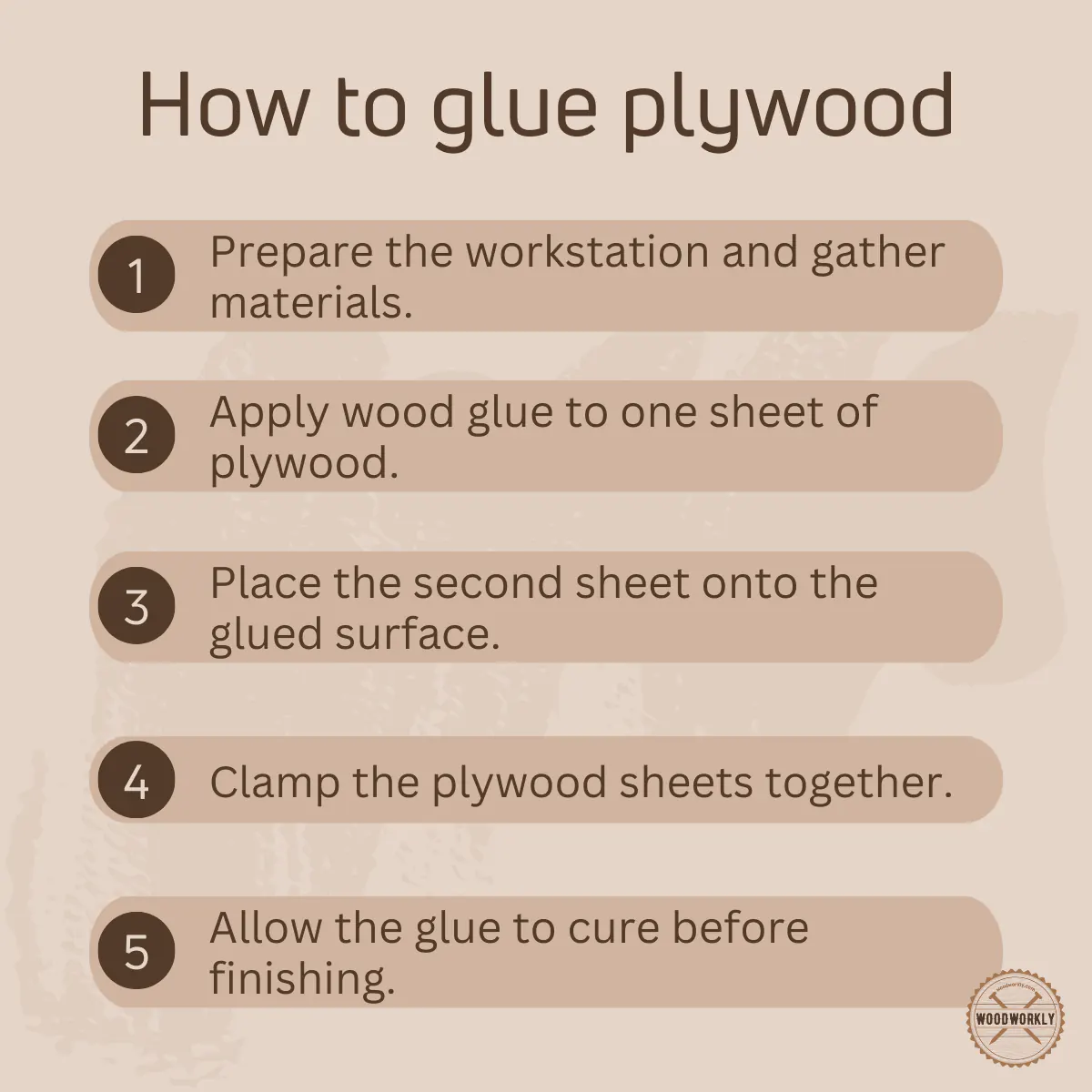
Supplies You Will Need Glue Plywood Together
When starting a plywood gluing project, having the right supplies will go a long way toward a successful and long-lasting bond.
I’ve created a simple list of the essential supplies you’ll need.
- Wood glue
- Clamps
- Sand paper
- Clean cloth or rag
- Applicator or brush
- Drying space
- Reinforcement material (optional)
- Safety gear
- Manufacturer guidelines
By gathering these simple supplies and following the proper procedures, you’ll be well equipped to effectively glue plywood to your woodworking projects.
How To Glue Plywood Together
Did you know that gluing plywood together is a simple process?
When gluing plywood is done correctly, you can create a strong and durable bond.
Here are the steps to ensure a successful plywood gluing project,
- Prepare Your Work Surface
- Place the First Sheet on the Sawhorses
- Apply Wood Glue
- Spread Glue on the First Plywood Sheet
- Place the Second Sheet of Plywood
- Clamp the Plywood Sheets
- Drive the Screws into the Plywood Sheet
- Remove Excess Glue
- Let the Glue Cure
- Finish the Project
Now let’s talk about this step in detail.
1. Prepare Your Work Surface
First of all you need to create a conducive working environment.
Here first ventilate the area then remove obstructions and then clean the surface of dust and debris.
Set the saw horses on a stable, flat surface, leaving enough space for the plywood sheets.
Then add all the necessary materials including wood glue, clamps, sandpaper, clean cloth and safety gear. Seal surrounding areas with newspaper or plastic sheeting to prevent adhesive stains.
2. Place the First Sheet on the Sawhorses
If you are working with whole sheets, determine which side of each plywood sheet will face.
Lay the first sheet down on the saw horses. Then place the second sheet on top of it, creating a drill pattern for the screws. Then drill pilot holes, countersinking each hole slightly.
3. Apply Wood Glue
I advise you to determine the amount of wood glue needed in this step.
Apply a zigzag or wavy line using an applicator or dispenser to one sheet of plywood.
There is no certain way as long as there is enough to form a strong bond.
4. Spread Glue on the First Plywood Sheet
You can use a brayer, roller, or squeegee to spread the glue evenly over the entire first sheet of plywood. Don’t forget to ensure an even layer for a secure bond here.

5. Place the Second Sheet of Plywood
Place the second sheet on the glued surface, ensuring proper alignment.
If you can, place it while the glue is still wet. To avoid air pockets, use scrapers to gradually lower the second sheet.
6. Clamp the Plywood Sheets
In this step, clamp the glued plywood sheets together. Then make sure the edges are aligned.
Use cauls with wax paper to prevent marks later. Start clamping in the center, then gradually move toward the outer edges for even pressure.
7. Drive the Screws into the Plywood Sheet
Here, depending on the drill pattern, screw the plywood sheets together using wood or drywall screws.
Screw in slowly, making sure every hole is filled. This method provides you with additional clamping pressure.
8. Remove Excess Glue
Wipe off excess glue with a damp cloth as soon as the plywood is installed.
For dried glue, use plastic putty to remove it.
9. Let the Glue Cure
Always follow the manufacturer’s instructions for curing time.
Keep in mind that longer curing times increase bond strength. Use a fan to improve airflow and speed drying.
10. Finish the Project
Finally flip the plywood, sand with fine sandpaper, and clean the dust.
Then apply protective coatings, paints or stains. Finish the edges with wood filler or sand depending on the desired look.
By following these steps, you can effectively glue plywood together, creating a safe and professional bond for your woodworking projects.
Congrats folks! Now you know how to glue plywood together without messing things up using the right technique.

Now I’m going to share with you several tips that I’ve learned over the past yeast which are useful when glueing plywood.
The below tips will help you as well to get your desired result easily.
Some of the below tips were gathered from glue experts.
Tips for Gluing Plywood Together
Now I will share with you some tips that I use for gluing plywood together.
- Always ensure that the plywood surface is clean, dry and free of contaminants to create strong bonds.
- Always choose the right high-quality wood glue for your project.
- Use clamps to hold the plywood pieces together during the gluing process.
- Depending on the application, consider using screws or nails in addition to glue for added strength.
- Always follow the directions provided by the wood glue manufacturer.
- Be careful with the amount of glue applied. Too little can result in a poor bond, and too much clamping can be difficult.
- Use a brayer, roller, or squeegee to spread the glue evenly over the plywood surface.
- When laying the second sheet of plywood, be careful to introduce air pockets.
- Start pressing from the center of the plate and gradually move towards the outer edges. This helps to achieve an even pressure and bond without gaps.
- As soon as the plywood pieces are secured, wipe off excess glue with a damp cloth.
- Always follow the recommended curing time provided by the adhesive manufacturer.
- After the glue has cured, finish the plywood with a protective coating, paint or stain.
By incorporating these tips, you can improve the efficiency of gluing plywood together and ensure reliable and long-lasting results for your woodworking endeavors.
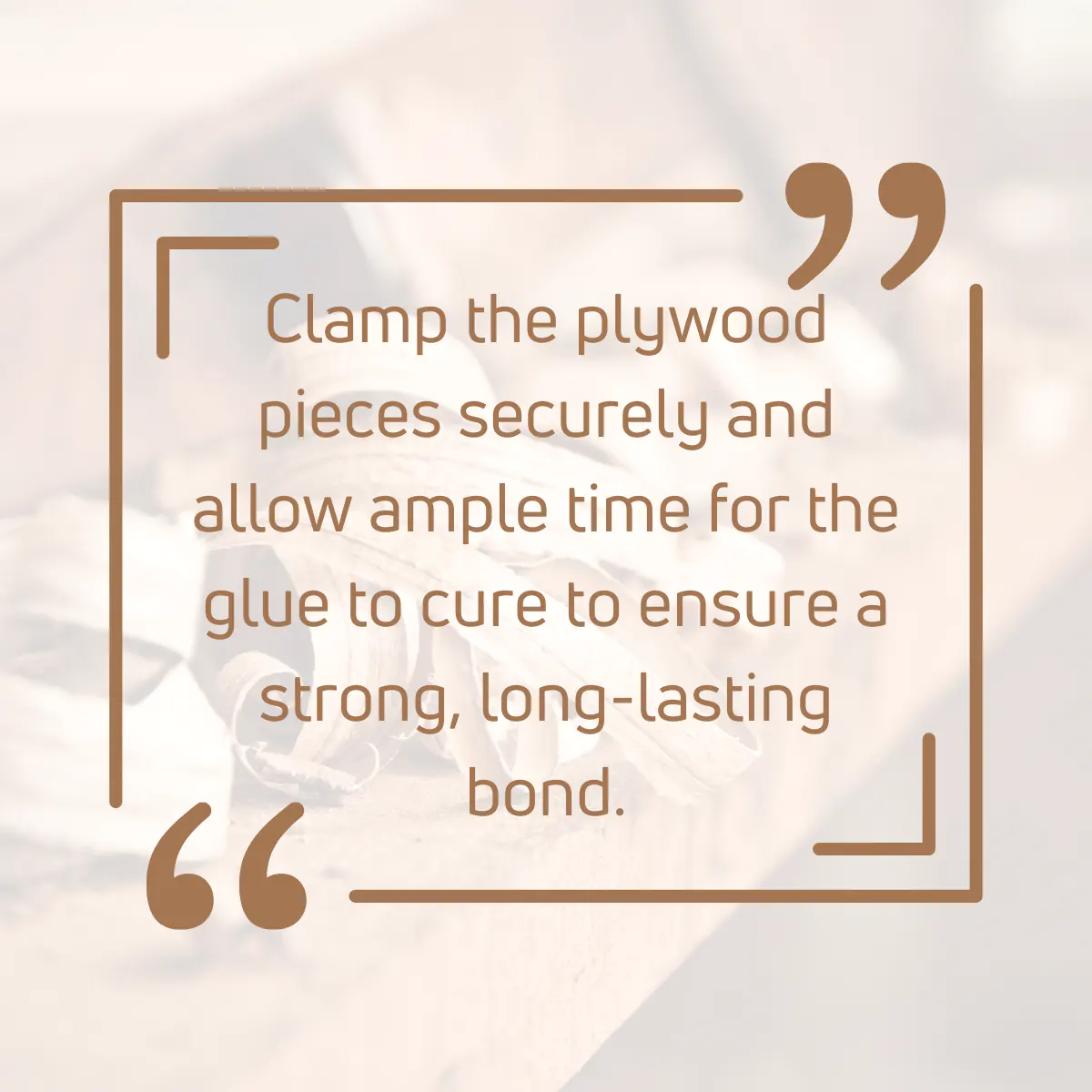
So, let’s answer some frequently asked questions.
FAQs
What types of glue are suitable for bonding plywood together?
PVA wood glue, polyurethane glue, and epoxy glue are commonly used for joining plywood sheets. Titebond and Gorilla Glue are popular brands that provide strong adhesion and durability.
How do I prepare the workspace for gluing plywood?
Clear the area of obstructions and debris, ensure good ventilation, and lay down newspapers or plastic sheets to catch excess adhesive. Wearing safety equipment like gloves and glasses is also essential to protect yourself.
What is the process of applying glue to plywood sheets?
Apply the adhesive in an even layer on one sheet of plywood using a roller, brayer, or squeegee. The amount should be sufficient to bond but not excessive to avoid slippage or oozing.
How can I ensure a strong bond between plywood sheets?
Align the sheets precisely, use clamps or cauls to apply pressure, and let the adhesive cure for the recommended time. Screws can also be added to strengthen the bond while the glue dries.
How do I remove excess glue after joining the plywood?
Wipe off the excess glue with a damp rag immediately after clamping the plywood sheets together. For dried glue, a plastic putty knife can be used to scrape it off gently.
How long should I wait for the glue to cure?
Follow the curing time specified in the glue manufacturer’s instructions. Allowing ample time for the glue to cure ensures a strong and durable bond between the plywood sheets.
Can I use contact cement for gluing plywood?
Contact cement is not recommended for bonding plywood layers due to its inadequate clamping pressure and bonding strength. Instead, use specific wood glues or epoxy for a stronger bond.
How do I finish the edges of glued plywood?
Use wood filler or power sanding to smoothen the edges. Applying a thick paste of wood filler, letting it dry, and then sanding can achieve a smooth, finished edge.
Is clamping necessary when gluing plywood?
Clamping provides pressure that ensures a tight bond between the plywood sheets. Using cauls or clamps is highly recommended to eliminate gaps and ensure even adhesion.
How do I select the right type of plywood for my project?
Choose the plywood type based on the project’s specific needs and environment, considering options like softwood, hardwood, marine-grade, or Baltic birch plywood for appropriate strength and durability.
Did I cover all you wanted to know about: How to Glue Plywood Together
In this article, I’ve deeply discussed how to glue plywood together using appropriate methods with skill.
To glue plywood together, apply an even layer of wood glue, such as PVA or epoxy, on one sheet of plywood. Place the second sheet on top, aligning the edges. Clamp or screw the sheets together to secure them while drying. Allow the adhesive to cure as per manufacturer’s instructions before finishing and using the bonded plywood.
Furthermore, I’ve answered some frequently asked questions a swell.
Hope you’ve learned everything you wanted to know about how to glue plywood together in detail with experts’ tips.
Now it’s time for you to start joining scrap plywood pieces together first using the above method. Practice several times with scarp wood pieces and then go for the main project. All the best!